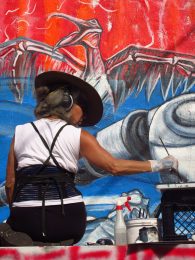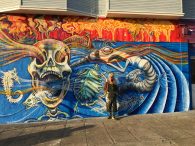RETHINK JUSTICE: PARTICIPANT PROFILES AND CURRICULUM
See what participants are doing in their classrooms and in the world outside of the academy.
NOLA HADLEY-TORRES
Standing Rock/No Dakota Access Pipe Line Syllabus: https://nycstandswithstandingrock.wordpress.com/standingrocksyllabus/
Juana Alicia Araiza: Activist Profile
Juana Alicia Araiza, Artist, Activist and Educator
I work in many different media to create both private and public works of art. These include drawing, printmaking, small-format painting, monumental acrylic, fresco, tile and sculptural murals and other sculptural forms. My work evolved from the streets of San Francisco’s Mission District, whose mural renaissance is legendary, to installations in other parts of the U.S. and Latin America. I began painting a
crylic murals, and expanded to ceramics, bas relief, cement and metal sculpture. I seek to create more and more architectonic and sculptural works in a cityscape with an increasingly green and sustainable urban vision.
I feel that it is my responsibility as an artist to be an activist for social justice, human rights and environmental health, and I see the work of parenting and teaching akin to being an artist. I began working as an artist in my teens; coming of age in the human rights movements that included the United Farm Workers and that protested the war in Vietnam.
I work in many forms and traditions, with a particular dedication to the fresco buono, an ancient painting technique that, practiced all over the world, has endured many centuries. The majority of my public works are in the Bay Area, but I have also painted murals in other parts of the world, including Mérida, Yucatán, Mexico and Managua, Nicaragua. Some of my works are individual and others are collaborative.
I am most known for my large public murals and mosaic installations created in the U.S. and Latin America. My current work is a new mural for the people of the East Bay, located at the corners of Adeline and Emerson Streets, across from the Ashby BART Station, in Berkeley.
Artist Statement, The SPILL Mural

Spill/Derrame, acrylic mural on stucco, Adeline and Emerson Streets, Berkeley, CA Juana Alicia©2016, All Rights Reserved
Spill Mural, In-progress, November 14, 2016
Spill/Derrame, acrylic mural on stucco, Adeline and Emerson Streets, Berkeley, CA Juana Alicia©2016, All Rights Reserved
This mural, SPILL/DERRAME, is dedicated to all life forms in the Gulf of Mexico, where the Deepwater Horizon oil spill took place on April 20, 2010. As you probably know, an explosion on the Deepwater Horizon Macondo oil well drilling platform started the largest marine oil spill in maritime history, dumping 4.2 million barrels of oil, and officials subsequently released 1.8 million gallons of Corexit, a chemical dispersant used to break up the oil, into the Gulf before the well was sealed.[1] I was deeply disturbed by this event, as I spend much of my life enjoying, admiring and being nurtured by those Gulf waters, in the small village of Telchác, Yucatán, Mexico.
I feel that it is my responsibility as an artist to be an activist for social justice, human rights and environmental health, and this piece addresses all of these issues. As we face multi-faceted assaults on the environment, and on all of the elements and species that live on this precious planet, I see my job as to create images that work for them. I bring images that awaken, shock, challenge and hopefully, raise consciousness, to provoke thinking, discussion and action on the part of those that “read” them on the streets of our cities, or within the walls of schools, hospitals, labor unions and other sites of social interaction and critical thought. I also seek to bring beauty, hope and healing to the urban environment via the mural form.
As we watch and support the present struggle of our brothers and sisters at the Standing Rock Sioux Reservation on the banks of the Missouri River, we feel the ongoing urgency to protect the waters of the planet and all of the species that depend on them. This mural is dedicated to those fierce Earth Protectors, and to all of the pueblos around the world that are fighting to keep the oil in the ground, and to re-establish both environmental and spiritual balance. We know that the planet is in crisis, and that the timeline for reversing the effects of rampant, unbridled exploitation of her resources, is short. I appreciate the support of the Bay Area Mural Festival, La Peña Cultural Center, and the California Arts Council, community volunteers, my assistant Keena Romano, and my students from Berkeley City College, for enabling the production of this mural.
[1] Six years later, controversy still rages about the wisdom of carpet-bombing the Gulf with these chemicals, and newly released documents reveal that government scientists expressed concern at the time about the health consequences of mixing such large quantities of dispersants with the millions of barrels of sweet crude. Occupational health experts now believe it created a toxic mix that sickened thousands of locals—including some of the 47,000 people that worked in some capacity on BP’s cleanup operation—crippling them with chemically induced illnesses that doctors are unable to treat. TECH & SCIENCEDEEPWATER HORIZON OIL DISASTER EXTENDS ITS TOXIC REACH
BY LINDA MARSA ON 10/10/16 AT 10:25 AM
Rethink Justice Curricula
For my painting class at beginning, intermediate and advanced levels, we address issues of climate change and environmental justice in the following assignment:
PAINTING ASSIGNMENT III: SURREALISM AND THE LANDSCAPE
PART 1 WRITTEN BRAINSTORM
To begin, create a written picture of what you are interested in painting:
• Description of the setting: Urban or rural, terrestrial or marine
• Use adjectives describing color, atmosphere, background, middle ground and foreground
•Perspective: aerial/bird’s eye view or worm’s eye view or otherwise
• Inhabitants of your imaginary landscape
• Surreal elements: elements of surprise, strange juxtapositions, dreams/nightmares
Example by THEA CRISTMAN – Tuesday, 27 September 2016, 3:53 PM
My painting may take place on a hilltop looking down on my neighborhood. In the foreground I will have golden grass and a few California poppies. In the middle ground I will show civilization as a rash, or virus covering the earths surface. I will depict the earths heat or it’s fever with warm colors. In the background I may show the polluted bay. It will be elevated view. The earth may look more alive, its crust more skin like. The houses will be all red to make them look more rash-like. I may have more human-like feature immerge from the earths surface such as a leg, arm, or eye. I want to show how ill the earth is. I want to depict the different ways the earth will defend and rid itself of this terrible human virus.
Example by DEVAN BENTLEY – Tuesday, 27 September 2016, 12:16 PM
My surrealist landscape takes place both in urban and rural areas. The urban, industrial, polluted dark area is the dystopian nightmare that is close to the current state of our country/planet. I want to make this in the foreground, looking out into different options or pathways we could take possibly. The separation would be utopian/dystopian themed, but also in the way that depending on which path you choose and what the future of that could be. And maybe by using foreshortening, as you go into the distance it could be showing time passing.
Maybe through electric, green energy cars, you can be taken to a utopia of dreamlike place where people of all cultures are getting along. We’re growing our own food on farms. We’re giving back to the land that we need to survive. We’re using renewable green energies, that with the help of technology (and as long as we keep our planet going) we can use all the time. We’re socially all accepting of each other, no matter our physical/mental abilities, skin color, background, language, etc. The grass is green, the air is clean, We’ve removed the industrial, paved road look that destroys our ground and we have replaced it with more trees. there are people riding bikes. There are people using transit (bart trains) that are solar or electric. There still requires a lot of housing for people, but we’ve done this with buildings that are solar powered. There are windmills. There are water falls…
In the dystopia, there are tons and tons of cars. you’re stuck in traffic to get there. I think I want to make it even further down into where the country/world could go of a complete nightmare. Like Trump being president. People being taken out of their homes, racists with guns, yelling, but just continuing to destroy the planet. there are turnpikes, full of cars, and smog. People are yelling at each other. There are buildings everywhere. There are homeless, there are people starving while there are people OVER eating. There’s a lack of balance. there are fires, the water is polluted, The air is polluted, it’s loud. What is everyone working for? Themselves? There’s no hope or point to these people’s lives other than to get ahead or get over someone else, get above to the top, instead of just be among everyone equally. There are TV screens everywhere. It looks like a scene from the book 1984. There is control, and there are lies and propaganda, s
PART 2 RESEARCH
Research an aspect of climate change/global warming that you will reflect in your surreal landscape.
Cite a minimum of three articles, videos or essays on the topic.
PART 3 PLEIN AIR PAINTING OF THE LANDSCAPE
Create 6 watercolor thumbnails and one full page watercolor in sketchbook at the Berkeley Arboretum or other landscape.Example by TIFFANY BRAUN
Landscape Sketches at Blake Gardens
by TIFFANY BRAUN
PART 4 FINAL ACRYLIC PAINTING
On 18″ x 24″ canvas, found object or wooden surface, create a landscape painting including foreground, middle ground, background, and atmospheric perspective. Using your landscape studies from the botanical gardens, create a surrealist version of the environment. Taking into consideration the current state of the planet and climate change, introduce elements of strange juxtaposition, surprise, dreams, fantasy. DUE: October 25
Lena Toney, Landscape

 Canvas
Canvas
 Donate
Donate
 Let's Talk!
Let's Talk!
